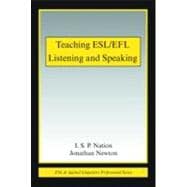
| Parts and goals of a listening and speaking course | |
| The four strands A commonsense justification of the four strands | |
| Learning through listening and reading | |
| Learning through speaking and writing Language-focused learning | |
| Becoming fluent in listening, speaking, reading and writing | |
| Balancing the four strands Integrating the four strands | |
| Principles and the four strands Learning goals | |
| Beginning to listen and speak in another language | |
| What should they learn? | |
| How should the teaching and learning be done? | |
| Practising sentence patterns | |
| Guiding listening and speaking | |
| Techniques for early meaning-focused speaking | |
| Planning a listening and speaking programme for beginners | |
| Listening Listening and language learning | |
| Advanced listening: Notetaking How to take notes | |
| Learning how to take notes | |
| Monitoring notetaking Monitoring meaning focused listening | |
| Learning through interaction and negotiation | |
| Encouraging negotiation Using written input to encourage negotiation | |
| Using information distribution to encourage negotiation | |
| Factors affecting the amount and type of negotiation | |
| Using learner training to encourage negotiation Monitoring negotiation | |
| Learning through non-negotiated interaction | |
| Understanding language teaching tasks: Ranking What is a ranking task? | |
| Method steps What can you use ranking tasks for? | |
| How can you make and prepare for ranking tasks? | |
| What material can you base ranking tasks on? | |
| Monitoring a ranking task Monitoring learners beginning to speak | |
| Learning through pushed output Pushed output | |
| Pushing output Formal speaking | |
| The nature of formal speaking | |
| Teaching formal speaking | |
| A process approach to formal speaking | |
| Guidelines for presenting a formal talk | |
| Pronunciation The place of form focused pronunciation instruction | |
| Factors affecting the learning of another sound system | |
| Procedures and techniques Fitting pronunciation into a course Monitoring pronunciation | |
| Deliberate teaching | |
| The value and limits of language-focused learning Deliberate vocabulary learning | |
| The requirements of language-focused vocabulary instruction | |
| Techniques and procedures Deliberate grammar learning | |
| The causes of error | |
| The effect of correction Correction procedures | |
| Fitting language-focused learning into a course | |
| Dictation and related activities Dictation Pre-dictation exercises | |
| Variations of dictation Related techniques | |
| Monitoring dictation Dicto-comp Related techniques | |
| Developing fluency | |
| The nature of fluency Fluency and accuracy Developing fluency | |
| Designing fluency activities Fitting fluency into a course Developing fluency in listening and speaking | |
| Techniques for developing fluency in listening | |
| Techniques for developing fluency in speaking Monitoring fluency tasks | |
| Testing Monitoring progress | |
| Testing listening and speaking Listening tests Speaking tests | |
| The survival syllabus | |
| The most useful words for beginning graded reading | |
| Topic types | |
| Topics for listening and speaking | |
| Table of Contents provided by Publisher. All Rights Reserved. |
The New copy of this book will include any supplemental materials advertised. Please check the title of the book to determine if it should include any access cards, study guides, lab manuals, CDs, etc.
The Used, Rental and eBook copies of this book are not guaranteed to include any supplemental materials. Typically, only the book itself is included. This is true even if the title states it includes any access cards, study guides, lab manuals, CDs, etc.